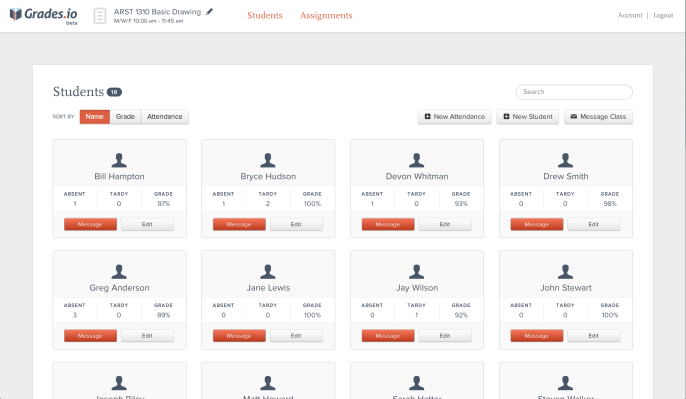When Arkansas-based entrepreneur and designer Arlton Lowry finally got the opportunity to teach a college class (one of his life-long goals), he found that the options for managing said class on the web weren’t very good. Blackboard was in use at the University of Arkansas at Little Rock, but no one was using it because it’s very unpleasant and somewhat complicated. Other options were equally unfulfilling, so he built his own with co-founder Shane Reustle, a New York-based entrepreneur and world traveler.
What Lowry and Reustle built was Grades.io, which launches today as an early MVP, after around six weeks of total development time. While not as feature-complete or as final in terms of design as Lowry plans to make it, even the MVP of Grades.io is worlds better than the bulk of available class management software, and that’s mostly because its design and user experience has been approached with a light touch.
“I just wanted to be able to easily manage my students, manage my class and assignments and get through the day,” Lowry explained in an interview. “I didn’t want to have to sit up there and try to figure out the application. With something like managing your class, and with applications in general, you shouldn’t have to learn how to use it, it should be very intuitive.”
Intuitive is the word to describe Grades.io. A simple web app, it starts you off with a clean slate and displays tooltips to guide you through setting up a class. The entire process happens on one page, with popover menus and dialogs taking you through course creation. You can then add students to a class, conduct attendance from the app, and track their grades from a simple, no-frills class profile page. Assignment creation is equally painless and comes with a simple visual editor, due date and total points possible for a perfect grade.
[gallery ids="860862,860846,860845"]
The feature set is intentionally light and will likely remain that way. After gathering feedback from early users, Lowry plans to add some things, but will do so only when it seems necessary, since the point is not to overwhelm users or give them another complicated system to learn. Feedback buttons throughout the site should help the team pinpoint what needs adding and what doesn’t.
“We’re not going to offer anything, we’re going to offer what the bulk of teachers and professors need, too,” Lowry said. “Depending on how things go, we’ll be offering plug-ins and extensions to make things easier to tailor for different needs, too. For instance right now we’re focused on colleges, but if we decide to target high school age students and teachers, there may be features that administrators need to add on that we can add on, but we’ll be sticking to the overall philosophy of ease of design and intuitive use.”
Grades.io is bootstrapped, and Lowry says they plan to keep it that way in the near-term. It helps that the company already has a revenue model in place out the gate, with free users getting one class, but unlimited classes available for just $5 per month. For now, the startup is targeting individual users and educators, but eventually, will likely try to sell to institutions, too. It’s a well-designed product that avoids many of the pitfalls educational software is often subject to, so here’s hoping it catches on.
